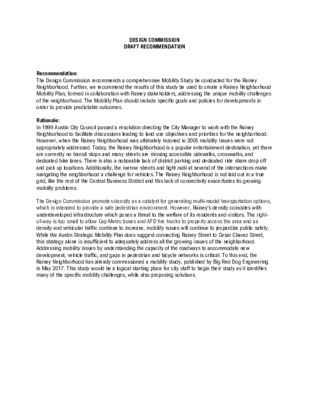Item 3a - Draft Recommendation for Rainey Neighborhood — original pdf
Backup

DESIGN COMMISSION DRAFT RECOMMENDATION Recommendation: The Design Commission recommends a comprehensive Mobility Study be conducted for the Rainey Neighborhood. Further, we recommend the results of this study be used to create a Rainey Neighborhood Mobility Plan, formed in collaboration with Rainey stakeholders, addressing the unique mobility challenges of the neighborhood. The Mobility Plan should include specific goals and policies for developments in order to provide predictable outcomes. Rationale: In 1999 Austin City Council passed a resolution directing the City Manager to work with the Rainey Neighborhood to facilitate discussions leading to land use objectives and priorities for the neighborhood. However, when the Rainey Neighborhood was ultimately rezoned in 2005 mobility issues were not appropriately addressed. Today, the Rainey Neighborhood is a popular entertainment destination, yet there are currently no transit stops and many streets are missing accessible sidewalks, crosswalks, and dedicated bike lanes. There is also a noticeable lack of district parking and dedicated ride share drop off and pick up locations. Additionally, the narrow streets and tight radii at several of the intersections make navigating the neighborhood a challenge for vehicles. The Rainey Neighborhood is not laid out in a true grid, like the rest of the Central Business District and this lack of connectivity exacerbates its growing mobility problems. The Design Commission promotes density as a catalyst for generating multi-modal transportation options, which is intended to provide a safe pedestrian environment. However, Rainey’s density coincides with underdeveloped infrastructure which poses a threat to the welfare of its residents and visitors. The right-of-way is too small to allow Cap Metro buses and AFD fire trucks to properly access the area and as density and vehicular traffic continue to increase, mobility issues will continue to jeopardize public safety. While the Austin Strategic Mobility Plan does suggest connecting Rainey Street to Cesar Chavez Street, this strategy alone is insufficient to adequately address all the growing issues of the neighborhood. Addressing mobility issues by understanding the capacity of the roadways to accommodate new development, vehicle traffic, and gaps in pedestrian and bicycle networks is critical. To this end, the Rainey Neighborhood has already commissioned a mobility study, published by Big Red Dog Engineering in May 2017. This study would be a logical starting place for city staff to begin their study as it identifies many of the specific mobility challenges, while also proposing solutions.